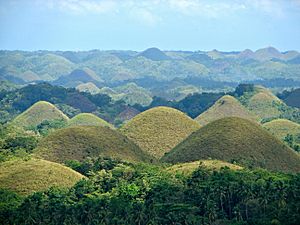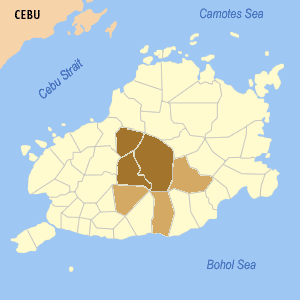Chocolate Hills facts for kids

The Chocolate Hills are amazing natural hills found in Bohol Province, Philippines. There are over 1,260 of these hills, covering more than 50 square kilometers. They are usually covered in green grass. But during the dry season, the grass turns brown, making the hills look like giant chocolate kisses! That's how they got their sweet name.
These hills are a very popular place for tourists to visit in Bohol. They are so important that you can even see them on Bohol's flag and official seal! The Philippine government has named them a National Geological Monument. There's also a plan to make them a UNESCO World Heritage Site, which means they would be recognized as important to the whole world.
The Chocolate Hills are cone-shaped karst hills. Karst hills are formed when limestone dissolves. They are similar to hills found in places like Slovenia, Croatia, and Puerto Rico. Scientists believe these hills started as corals growing in a warm, shallow sea about two million years ago.
The hills are made of sandy limestone that contains many fossils of tiny sea creatures and algae. Over time, rainwater and groundwater slowly dissolved the limestone. After the land was lifted above sea level, rivers and streams also helped shape them. The hills are separated by flat areas and have many caves and springs. The Chocolate Hills are a wonderful example of this special type of landform.
Contents
What Do the Chocolate Hills Look Like?
The Chocolate Hills look like many haystacks or mounds. They are generally cone-shaped and almost perfectly symmetrical. There are between 1,268 and 1,776 of these individual mounds.
These cone-shaped or dome-shaped hills are made of grass-covered limestone. The hills vary in size. Some are 30 to 50 meters (about 98 to 164 feet) high. The tallest one reaches 120 meters (about 394 feet) in height. These unique hills are scattered across the towns of Carmen, Batuan, and Sagbayan in Bohol.
During the dry season, the grass on the hills dries up. It turns a beautiful chocolate brown color. This makes the whole area look like endless rows of "chocolate kisses". This famous candy is actually what inspired the name "Chocolate Hills."
Fun Legends About the Hills
People have told many stories about how the Chocolate Hills were formed. Here are three popular legends:
Giants Fighting
One story tells of two angry giants who fought for many days. They threw rocks, boulders, and sand at each other. Both giants became very tired from the long fight. They eventually forgot their feud and became friends. But when they left, they forgot to clean up the huge mess they had made. This mess became the Chocolate Hills.
A Giant's Sad Tears
Another more romantic legend is about a powerful and young giant named Arogo. Arogo fell deeply in love with a regular human girl named Aloya. When Aloya died, Arogo was filled with great pain and sadness. He cried and cried, and his tears would not stop. When his giant tears finally dried, they formed the Chocolate Hills.
A Carabao's Upset Stomach
The third legend tells of a town that was bothered by a giant carabao (a type of water buffalo). This carabao ate all of the town's crops. The townsfolk had enough! They gathered all their spoiled food and placed it where the carabao would surely find it. The carabao ate the bad food, but his stomach couldn't handle it. He got sick and left behind many mounds of waste until his stomach was empty. These mounds then dried up, forming the Chocolate Hills.
Images for kids
See also
 In Spanish: Colinas de Chocolate para niños
In Spanish: Colinas de Chocolate para niños






